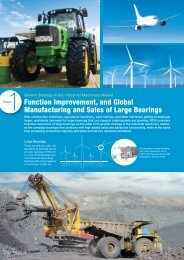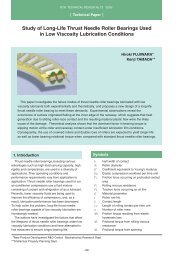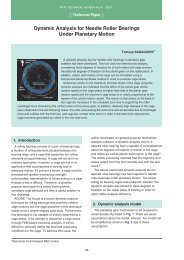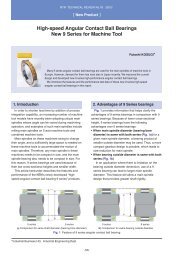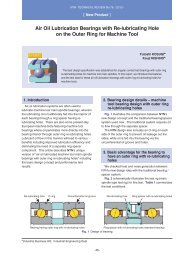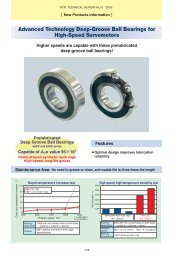Special Issue; Products for Industrial Machinery - NTN
Special Issue; Products for Industrial Machinery - NTN
Special Issue; Products for Industrial Machinery - NTN
You also want an ePaper? Increase the reach of your titles
YUMPU automatically turns print PDFs into web optimized ePapers that Google loves.
<strong>NTN</strong> TECHNICAL REVIEW No742006<br />
Introduction of an Award-Winning Product<br />
2005 Monozukuri Buhin Taisho Grand Prix Machine Component Award<br />
Monodrive Two-Way Feeder<br />
Toshio OGUSU<br />
The Monodrive Two-Way Feeder is a parts feeder<br />
where parts can be moved in two directions (the line<br />
supply side and the other side) by one driving unit.<br />
This reduces the driving unit and controller set from<br />
two pieces to only one piece. There<strong>for</strong>e, the feeder<br />
becomes smaller and lighter, with reductions in power<br />
consumption, cost, and maintenance.<br />
1. Introduction<br />
<strong>NTN</strong>’s Monodrive Two-Way Feeder is a unique<br />
compact vibratory parts feeder optimized <strong>for</strong> feeding<br />
many part types in smaller lots, and boasting greatly<br />
decreased floor space requirements compared with<br />
conventional bowl-type parts feeders.<br />
As many bulk parts and components are now<br />
manufactured in plants outside Japan, automatic<br />
assembly lines in Japan are increasingly required to<br />
be capable of producing more product types in smaller<br />
lot sizes, thereby demands are growing <strong>for</strong> less<br />
expensive, more compact parts feeding devices. So<br />
far, the conventional parts feeder systems used <strong>for</strong><br />
this purpose have generally consisted of a cylindrical<br />
bowl feeder type that aligns the parts by vibration and<br />
a linear feeder type that feeds the parts to the<br />
assemblers. In this arrangement, the floor space<br />
required <strong>for</strong> the bowl feeder section is often great.<br />
There<strong>for</strong>e, believing that a unique driving unit capable<br />
of the entire process of parts alignment and feeding<br />
would dramatically raise user satisfaction, the author<br />
began his commitment to the development and<br />
commercial release of the Monodrive Two-Way<br />
Feeder product.<br />
The design concept and novel operating principle of<br />
this product have been highly evaluated, and it even<br />
received the 2005 Monozukuri Buhin Taisho Machine<br />
Component Award sponsored by Nikkan Kogyo<br />
Shimbun, Ltd., a leading Japanese industrial paper.<br />
This award was given to outstanding machine<br />
components among those developed or brought to<br />
market in the 2005 business year. In this report, the<br />
author would like to introduce this unique product to<br />
the readers.<br />
2. Overview of the Monodrive Two-Way<br />
Feeder<br />
Photo 1 shows the appearance of the author’s<br />
monodrive two-way feeder.<br />
In Table 1, the features of the author’s monodrive<br />
two-way feeder design are compared with those of<br />
conventional compact vibratory parts feeder systems.<br />
Various compact parts feeder designs that do not<br />
employ bowls have been available (Table 1).<br />
However, these products have drawbacks, including<br />
the need <strong>for</strong> two driving units and the difficulty of<br />
adjustment of the entire system.<br />
Requiring multiple assemblies, conventional parts<br />
feeder systems that use two linear feeders do not<br />
satisfy the needs <strong>for</strong> less expensive, compact parts<br />
feeding systems. There<strong>for</strong>e, the author tried various<br />
ideas <strong>for</strong> parts feeding systems in which one linear<br />
feeder unit could feed the parts. As a result of these<br />
attempts, the author has incorporated a vibrationdirection<br />
switching leaf spring unit (Photo 2) into a<br />
conventional linear feeder. Thus, the author has<br />
Product Engineering Department Precision Equipment Division<br />
-104-



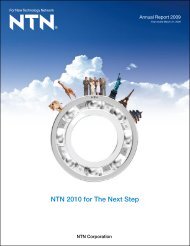
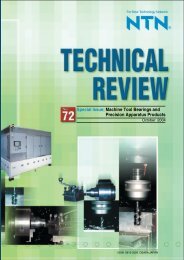
![[New Product] Unit Products for Office Equipment - NTN](https://img.yumpu.com/27154451/1/184x260/new-product-unit-products-for-office-equipment-ntn.jpg?quality=85)
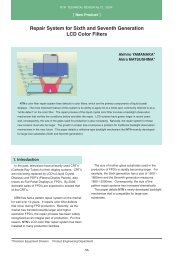
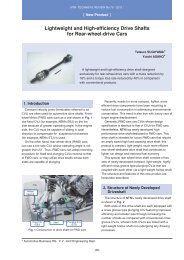
![[New Product] Development of Oil-impregnated Sintered ... - NTN](https://img.yumpu.com/27154427/1/184x260/new-product-development-of-oil-impregnated-sintered-ntn.jpg?quality=85)

